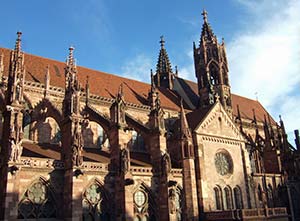| Germany Index | Europe for Visitors |
|
|
Freiburg PhotosFrom: Freiburg im Breisgau, Germany
The Münsterplatz is the physical and spiritual heart of Freiburg's Altstadt. The Münster (left) was begun in 1200 A.D. and took more than 300 years to complete. It was a parish church until 1821, when Freiburg acquired an archbishop and the church became a cathedral. Whether by luck or divine intervention, the Münster was undamaged by the many wars and seiges that took place over the centuries, including the Allied bombing that destroyed much of Freiburg's Altstadt on November 27, 1944. In the distance, behind the old guardhouse known as the Alte Wache (now a showroom for Baden wines), you can see the Schlossberg, which is part of Germany's Black Forest. Here are more photos with captions:  This picture shows the south side of the Münster, which acquired a Renaissance vestibule in 1620 (the year that the Mayflower and the Pilgrims arrived in America).
You can ascend the Münster's tower for a small fee, and the view is well worth the climb. (In addition to looking down on the Münsterplatz, you can look up and see the sky through the cathedal's latticework stone spire.
This view from the Münster tower shows the Alte Wache (with outdoor tables where you can sample regional wines) and a modern building at the eastern end of the Münsterplatz, where bombing destroyed existing houses in World War II.
Back down at ground level, the Münster's entrance is a backdrop for vendors on market days (Monday through Saturday, 7 a.m. to 1 p.m.)
The Münstermarkt, or cathedral market, gets underway at the crack of dawn as farmers, handicraft vendors, etc. arrive on the square.
The food vendors are among the first to reach and the last to leave the Münsterplatz on market days.
The busiest section of the market is on the north side of the Münster. On Saturday, when suburbanites come into town to shop, the crowds can seem overwhelming.
Produce, much of it direct from the farm, is just one good reason to shop at the Münstermarkt. (In spring, during Spargelsaison, asparagus is the main draw. If you don't have a way to cook it yourself, you'll find plenty of opportunities to dine on Spargel in Freiburg's restaurants.)
When you're exploring the Münsterplatz, take care to notice the details, such as the Georgsbrunnen (top) and the Madonna and child on a building façade.
Watch your feet when you're walking in the Altstadt: The streets are lined with Bächle, or water channels.
Many of the Bächle were paved over in modern times, but when Freiburg converted most of the Altstadt into a pedestrian zone in the 1970s and 1980s, the Bächle were reopened.
(We saw a young man step into the water on a December day in the Münsterplatz; his foot emerged wet but unhurt.)
Freiburg's pavements are decorated with icons made of cobblestones in contrasting colors. In Livable Cities Observed, Suzanne H. Crowhurst Lennard and Henry L. Lennard describe what happened when the Altstadt was pedestrianized several decades ago:
Other markers in Freiburg's cobblestones serve a different purpose: to remind citizens and visitors of the Holocaust and its victims. These two brass memorial markers honor Berthold and Elise Weil, who were deported from Freiburg in 1940 and murdered in the Auschwitz concentration camp two years later.
The Augustinerplatz is one of Freiburg's important squares. It lies a couple of blocks south of the Münsterplatz, near the southern boundary of the pedestrian zone.
The most important building on the Augustinerplatz is the Augustinermuseum, which occupies a former church and monastery that date back to 1300 A.D. The city-owned museum emphasizes art and historic objects from Baden and the Upper Rhine, and it has an especially fine collection of medieval church art. Its displays include the originals of sculptures from the Münster.
Fisherau and its neighboring streets of Gerberau and Insel run alongside a canal on the southern edge of the Altstadt. This district is packed with interesting little shops, restaurants, and beer gardens.
These houses are in Gerberau, just west of the Augustinerplatz.
The Haus zum Steinin Brücklin is on Insel. The house dates back to 1460, and one wing is built over the fast-moving waters of the canal.
Insel is also home to the Gasthaus zum Rauhen Mann...
...and to outdoor restaurants such as this beer garden, which overlooks the canal.
As you walk around old Freiburg, you'll see occasional surprises--such as this 19th Century building, where the term "outdoor seating" has a unique meaning.
This modern statue is on a wall overlooking the canal that runs from Metzgerau to Insel.
Freiburg's parks and other green spaces include the Colombipark, where the Colombischlössle (Colombi Palace) houses the Museum for Ancient and Early History. The museum is worth visiting just to see the interior of the restored palace.
The Schwabentor, a 13th century gate to the Altstadt, houses the Zinnfigurenklause, a museum of dioramas with tin or pewter figures.
Another medieval gate, the Martinstor (shown here behind the Münster's spire) has a McDonald's fast-food restaurant at ground level.
For great views of the city, climb up the Schlossberg, a hill just to the east of the Altstadt. The Schlossberg, which is covered by a huge public park, is Freiburg's gateway to the Scharzwald or Black Forest.
Follow the directional signs to the Schlossbergturm, or Schlossberg tower, an observation tower on top of the hill.
The Schlossbergturm opened in 2002. It consists of massive wooden posts around a steel cage and spiral staircase. On top, a smaller staircase leads to a crow's nest that offers a 360-degree view of Freiburg im Breisgau and the Black Forest. Photos marked "FWTM" are copyright © Freiburg Management Marketing.
|
|
| Germany for Visitors - Home | | Europe for Visitors - Home | | About us | | Press clippings | | Testimonials | Copyright © 1996-2024 Durant and Cheryl Imboden. All rights reserved. |